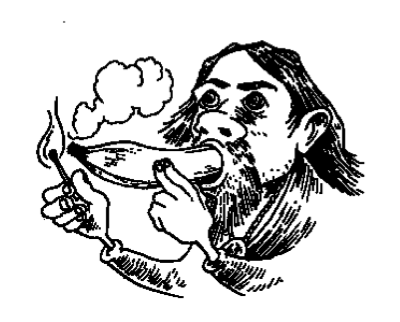In June 1967, journalist Sara Davidson visited New York City to report on a “three day cosmic love-in” taking place in Central Park. The young participants in this “hippie happening” costumed themselves in a medley of outrageous and sexually ambiguous fashions: tattered jeans and flannels, western boots, Benjamin Franklin glasses, Indian gear, and tie-dyed T-shirts. But especially noteworthy to Davidson was the sight of a young hippie in a wizard hat, selling bananas on an East Village corner. The bananas were being sold for ten cents each, with a three-cent deposit on the skins. “Anyone who heard [folksinger] Donovan sing ‘Mellow Yellow’ knew why,” she remembered. “Smoking banana peels could get you high. Outtaaaaa-sight!”
Throughout that spring and early summer, the notion that one could get high from smoking “banana joints” circulated widely, first in the underground press but also in the mainstream media and even among some gullible federal officials. Recipes for “bananadine powder”—the boiled, dried-up insides of banana peels, which was rolled into tobacco paper and smoked like marijuana—were frequently reprinted, and some clever entrepreneurs on the West Coast founded their own mail-order company that sold banana peels. “I hope to make $100,000 in the next six months on bananas,” boasted a partner in the firm. At a gathering in Central Park’s Sheep Meadow, hippies playfully regarded bananas as sacred totems; they gave a “banana pledge” (“one banana, under Banana, with liberty and justice for all…”) signaled to each other with a banana salute (“middle finger, up and bent”) and rallied around a large, wooden replica of a banana. Time and Newsweek both ran stories about the craze, and a New Jersey congressman named Frank Thompson, Jr. facetiously proposed the Banana Labeling Act of 1967, which would have required stickers on bananas that said “Caution: Banana Peel Smoking May Be Injurious to Your Health.” “From bananas it is a short but shocking step to other fruits,” Thompson intoned. “Today the cry is ‘burn, banana, burn.’ Tomorrow, we may face strawberry smoking, dried apricot inhaling, or prune puffing.”
On May 26, 1967, the Food and Drug Administration (FDA) issued a press release indicating that scientific analysis of several banana concoctions failed to produce “detectable quantities of known hallucinogenics.” One investigator later recalled, “We took thirty pounds of bananas into the lab, cooked, scraped, and did everything else to them that the underground papers told us to do. But it was a put-on.”
Perhaps it’s not surprising that historians have yet to examine the Great Banana Hoax of 1967. But a close look at the fad from an epistemological perspective—focusing on the hoax’s mysterious origins, meanings, and speedy cultural infiltration—underscores some of the important accomplishments of...
You have reached your article limit
Sign up for a digital subscription and continue reading all new issues, plus our entire archives, for just $1.50/month.
Already a subscriber? Sign in





